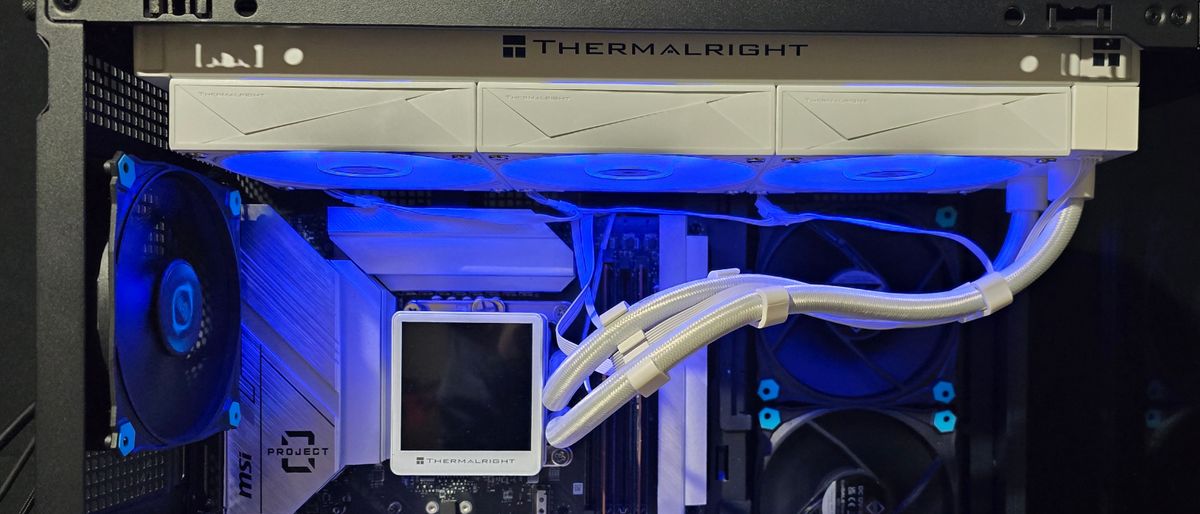Tom's Hardware Verdict
Once again, Thermalright raises the bar for performance and value with its latest screen-equipped AIO cooler, the Grand Vision 360.
Pros
- +
Industry-leading thermal performance
- +
Fancy display on CPU block
- +
Best noise normalized results I’ve seen yet
- +
More customization presets than any LCD AIO I’ve tested before
- +
Reasonable price of $129 USD
Cons
- -
Slightly louder than competitors when tied to a default fan curve
- -
Cable management could be better
Why you can trust Tom's Hardware
The last time I used the title of it’s not a competition, it is a massacre was when Thermalright released its Phantom Spirit 120 EVO air cooler. To this day I consider it one of the best options in air cooling. And after testing it, I’m equally impressed with Thermalright’s latest AIO, the Grand Vision 360.
This cooler not only has some of the best thermal performance I’ve seen from any AIO I’ve tested, but it also has a fancy LCD display with tons of preset customizations available, while retaining a reasonable price tag of $129. You can bet this one will soon be added to our list of the best coolers we’ve tested. But before it lands there, let’s take a look at the cooler’s features and specs, followed by its impressive results in our testing.
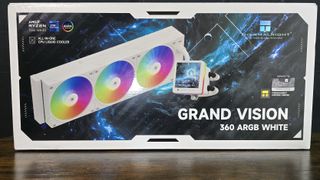
Cooler specifications
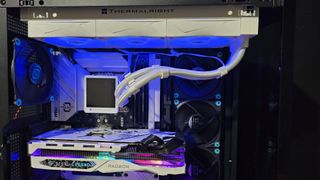
| Cooler | Thermalright Grand Vision 360 |
| MSRP | $129 (U.S.) |
| Radiator Material | Aluminum |
| Pump Speed | Up to 6400 RPM |
| Lighting | ARGB on fans, diffused lighting strip on CPU block |
| Warranty | 3 Years |
| Socket Compatibility | Intel Socket LGA 1851/1700/1200/115x AMD AM5 / AM4 |
| Unit Dimensions (including fans) | 403 (L) x 120 (W) x 53mm (D) |
| Base | Copper cold plate |
| Maximum TDP (Our Testing) | >265W with Intel’s i7-14700K |
Packing and included contents
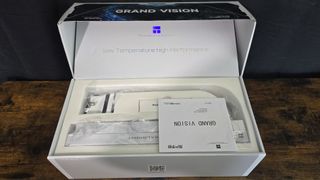
The Grand Vision 360 is the first product from Thermalright with packaging that I would describe as “fancy.” As you open the top, the white section with “low temperature, high performance” pops up. The product is secured with plastic wrappings and molded cardboard. The fans are preinstalled for convenience.
Included with the box are the following:
- Three 120mm fans
- 360mm radiator and CPU block
- Thermal Paste
- LCD Screen
- Mounting accessories for modern AMD & Intel platforms
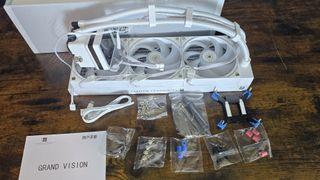
Features of Thermalright’s Grand Vision 360
*️⃣Thermalright TF7 Thermal Paste
Included with the AIO is a small tube of Thermalright’s TF7 thermal paste. This is one of the better pastes on the market, as you can see in our best thermal paste tests.
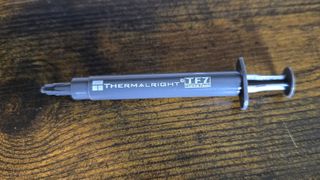
*️⃣ Accessible refill port
I go out of my way to recognize companies when that don’t include a consumer-unfriendly “warranty void if removed” sticker on top of the refill port – an action which is technically illegal under the Magnuson-Moss Warranty Act in the USA. Thermalright includes an accessible refill port hidden behind a sticker with its logo on it, so that users who wish to service their equipment can do so. Most users won’t have to do this during the three-year warranty rating, but it’s nice to have the option should the need arise.

*️⃣ 27mm radiator
The Grand Vision 360 includes a radiator 27mm thick, which is standard for most liquid coolers.
*️⃣ Fancy 3.4-inch display
One thing that immediately sets the Grand Vision 360 apart from its competitors, at least in this price range, is the inclusion of a 3.4-inch, 480x480-resolution screen.
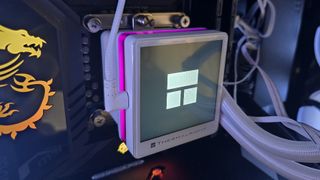
*️⃣Software with tons of customization options
You don’t need to install Thermalright’s software to operate the AIO normally, but you’ll need to download it if you wish to customize the display. Thermalright doesn’t make it obvious where to download the software, but this link will take you to the company’s TRCC software.
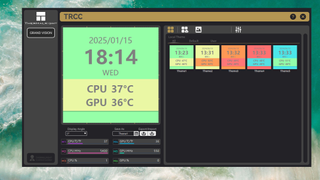
At first glance, you’ll see the screen shown above and might think that Thermalright’s software is rather basic. The software is deceptively simple looking, but exploring the options further reveals a wide variety of preset customization options – more than I’ve seen from any other AIO software I’ve used before!



*️⃣ Cable management features
Thermalright’s Grand Vision AIO features pre-installed fans with a quick-connect system; the cables are routed through the tubing of the AIO with clips. This was a good effort. But it ends up a tad bit messier than needed. This is a minor complaint in an otherwise stellar product.
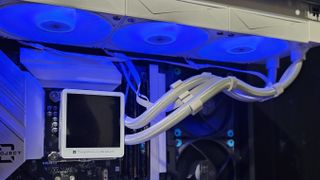
*️⃣ TL—H12-X28-S 120mm PWM fans
There’s more to a cooler than just the heatsink or radiator. The bundled fans have a significant impact on cooling and noise levels, as well as how the cooler looks in your case. The fans included are TL—H12-X28-S (that’s a mouthful!) 120mm PWM fans, which, as the benchmarks will show, enable strong cooling performance both at full speed and when restricted to low noise levels.
These fans are pre-installed and feature a quick-connect system, designed to save the user time and offer tidy cable management. They’re also slightly thicker than normal: 28mm instead of the normal 25mm fans.
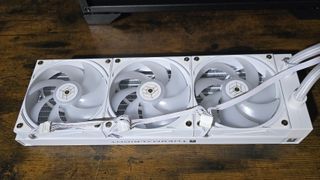
| Dimensions | 120 x 120 x 28mm |
| Fan Speed | Up to 2150 RPM |
| Air Flow | Up to 80.45 CFM |
| Air Pressure | Up to 2.65 mmH2O |
| Bearing Type | S-FDB V2 |
| Lighting | ARGB |
*️⃣ Full RAM Compatibility
Like almost every other AIO on the market, the Grand Vision 360 doesn’t interfere with or overhang RAM DIMMs in any manner – allowing for all sizes of RAM, no matter how tall.
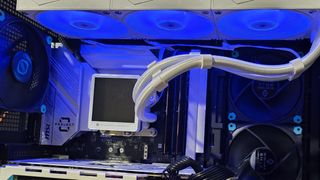
Testing configuration – Intel LGA1700 and LGA1851 platform
| CPU | Intel Core i7-14700K |
| GPU | ASRock Steel Legend Radeon 7900 GRE |
| Motherboard | MSI Z790 Project Zero |
| Case | MSI Pano 100L PZ Black |
| System Fans | Iceberg Thermal IceGale Silent |
There are many factors other than the CPU cooler that can influence your cooling performance, including the case you use and the fans installed in it. A system's motherboard can also influence this, especially if it suffers from bending, which results in poor cooler contact with the CPU.
To prevent bending from impacting our cooling results, we’ve installed Thermalright’s LGA 1700 contact frame into our testing rig. If your motherboard is affected by bending, your thermal results will be worse than those shown below. Not all motherboards are affected equally by this issue. I tested Raptor Lake CPUs in two motherboards. And while one of them showed significant thermal improvements after installing Thermalright’s LGA1700 contact frame, the other motherboard showed no difference in temperatures whatsoever! Check out our review of the contact frame for more information.
I’ve also tested this cooler with Intel’s latest platform, Arrow Lake and LGA 1851.
| CPU | Intel Core Ultra 9 285K |
| GPU | MSI Ventus 3X RTX 4070Ti Super |
| Motherboard | MSI Z890 Carbon Wifi |
| Case | MSI MPG Gungnir 300R |
| System fans | Pre-installed case fans |
LGA 1700 and 1851 Installation
The installation of the AIO is simple. The following steps assume that you will mount the radiator to your case first, which is generally a good idea unless you are building in a very cramped case.
1. You’ll first need to place the backplate against the rear of the motherboard.
2. Next, you’ll secure the backplate by attaching standoffs. You’ll then place the mounting bars on top of the standoffs, and secure them with the included screws.
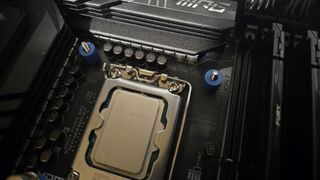
3. Apply the included thermal paste to your CPU. If you have any questions on how to do this properly, please refer to our handy guide on how to apply thermal paste.
4. Place the CPU block on top of the CPU, and secure it with a screwdriver.
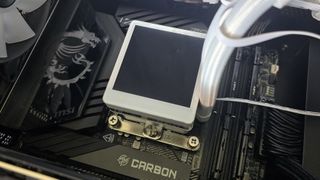
5. Connect the PWM and ARGB cables to your motherboard. If you wish to use the display, you’ll need to connect the USB cable to the CPU block on one end, and to a USB and SATA power header on the other ends.
6. Afterwards, power on your computer as installation is complete.
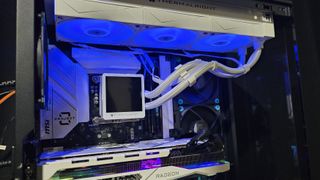

Albert Thomas is a contributor for Tom’s Hardware, primarily covering CPU cooling reviews.
-
Kindaian Remove the screen, remove the RGB and add a temperature sensor connection for the motherboard, and you will have a winner.Reply
As an option, add a mount faring for the space of a card connection or a standard fan mount (to increase the number of boxes it is compatible with.
And then you can take my money! -
SparklyIO I have a big-swing request: would you include in this and future reviews if the manufacturer has Linux compatible software for their features, like screen and fan curve? I assume these reviews are done on a windows OS (even stating that would help). Or, at least, report how everything works with no software customization installed (with only defaults?). TY!Reply -
thestryker It's always good to see affordable top performers. Thermalright seems to have several pretty interesting options in the AIO space.Reply
I wish they would do a version with a fan on top instead of the screen. I'm not sure it would be enough for what I want (DRAM airflow*) but it would probably maintain airflow around SSD and VRM. Silverstone's IceMyst is the most interesting option here to date from what I've seen.
The Thermalright website says 5 year warranty on the pump so I'm wondering if the packaging indicated something different.
*Nobody seems to have done much in this category (unless you're liquid cooling DRAM). They're all basically just takes on the old Corsair DRAM cooler where you strap a couple of fans on a bracket above the memory.
The fans are just PWM controlled and have separate connectors for PWM and ARGB so this should be able to be controlled vendor agnostic. I think whether or not there is Linux support and how it works without software are both great ideas.SparklyIO said:fan curve -
Albert.Thomas Reply
Thanks for pointing this out, I'm hoping that Linux becomes more mainstream in the near future. I'll definitely consider this and see if I can find confirmation of Linux support for future reviews.SparklyIO said:I have a big-swing request: would you include in this and future reviews if the manufacturer has Linux compatible software for their features, like screen and fan curve? I assume these reviews are done on a windows OS (even stating that would help). Or, at least, report how everything works with no software customization installed (with only defaults?). TY! -
Albert.Thomas Reply
Are you wanting to have the cooler operate according to a motherboard sensor? I'm curious to understand the logic behind this request.Kindaian said:add a temperature sensor connection for the motherboard -
YSCCC Am using their frozen edge 360 for a month and a half, tamed the 14900k perfectly with peak during R23 <80C with room temp 24C.Reply
TR always get top tier performance at half price or lower... The only question is unlike air coolers where it basically just won't fail except the fans, I wonder how long will it work or if it will have permeasion issues quicker than competition -
Cbedoya94 Would love to see the comparison between the 240 version and the peerless assassin 140Reply -
thestryker Reply
There is no stock cooler for higher end processorsm3city said:No comparison to stock/entry level air cooler.
the 285K is a new platform so testing is limited so far, but the Uphere C5C does show up on some of the gaming charts and it's sub $20
the 14700K charts have the Thermalright Assassin X 120 Refined SE listed and it's under $20.
